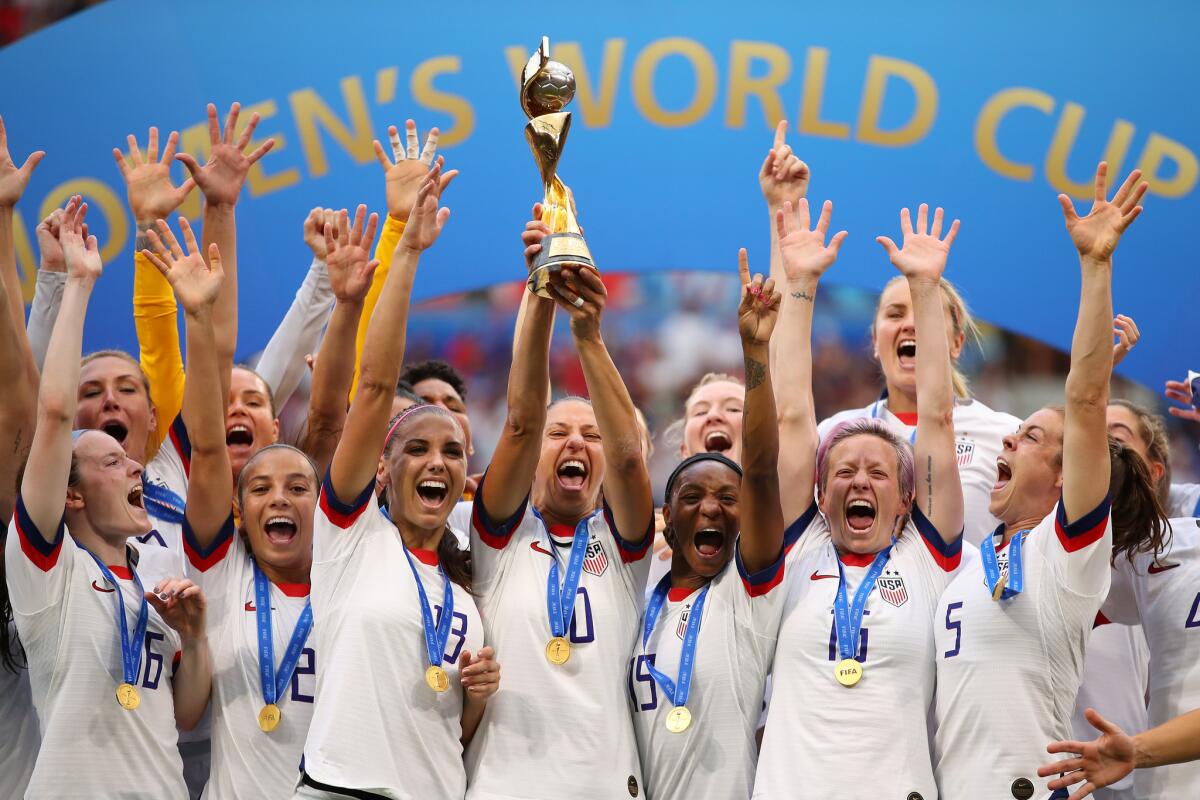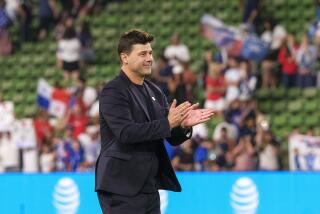What’s next for the U.S. women’s team after its World Cup win?

- Share via
Reporting from Lyon, France — The games are over and the celebration has just begun for the newly crowned Women’s World Cup champions. And while the hard work remains of consolidating what the U.S. won on its unbeaten run through the deepest field ever assembled for a women’s soccer tournament, the players appear content to let that wait.
For now.
“This is really fun, where we’re just partying and celebrating all of the last three years and everything that we put into this moment,” defender Becky Sauerbrunn said. “This is when we kind of get to decompress a little bit and just enjoy the moment.”
The team partied deep into Monday morning at a swank Lyon restaurant, with friends and family members lining up to take pictures with the World Cup trophy. When a U.S. Soccer staff member spotted Jill Ellis patiently waiting her turn at the end of the queue, she quickly guided the only coach to win the trophy twice to the front of the line.
“It was just fun to celebrate together,” goalkeeper Alyssa Naeher said. “The 23 of us have been on this journey together for a long time. We’ve put in a lot of blood, sweat and tears together.”
Asked if the magnitude of the team’s accomplishments has set in, the reserved Naeher smiled.
“It’s getting there,” she said.
The team took an early afternoon charter flight from Lyon — where it was cheered wildly at the airport — to Newark, N.J., and will make a round of the morning shows Tuesday before being honored with a ticker-tape parade through the streets of Manhattan on Wednesday.
After a short break the team will play a four-game victory tour, beginning with an Aug. 3 date at the Rose Bowl. By then the questions about what comes next will have to start being answered.
Ellis’ contract expires at the end of July, and though there is an option for another year — at $500,000, according to Yahoo Sports — on the table, there appears to be little left for her to accomplish. She’s already the longest-serving and most successful manager in U.S. Soccer history, is unbeaten in two World Cups and is just the second coach, male or female, to win two World Cups, matching Italy’s Vittorio Pozzo, who hoisted his last trophy more than 80 years ago.
The team — with an average age of just over 29 years, the second-oldest to win a Women’s World Cup — will remain largely intact, at least for the time being. Carli Lloyd, who turns 37 next week, is expected to play through the victory tour before making a decision about next summer’s Tokyo Olympics.
With the World Cup over, the players’ gender-discrimination lawsuit against their federation can also move forward, with the two sides expected to enter mediation perhaps as early as this week. Megan Rapinoe, the outspoken leader of the U.S. team, believes the World Cup win can only help the players’ argument that they should receive pay and working conditions more in line with what the men’s national team gets.
“This just sort of blows it out of the water,” said Rapinoe, one of five U.S. players who have played in the last three Women’s World Cup finals. “It isn’t even about that any more. It’s just about doing the right thing. The federation is in a unique position to kind of ride this wave of good fortune and get on board and hopefully set things right for the future.”
The Americans’ very public fight with their federation has galvanized a global movement for more funding and support for women’s soccer, the fruits of which were clear in France. In much of Europe, women were banned from playing soccer for much of the 20th century. Now domestic leagues are thriving across the continent, a big reason why seven of the eight World Cup quarterfinalists were from Europe.
FIFA, soccer’s world governing body, has been slow to join the movement, one reason Gianni Infantino, its president, was greeted with boos and chants of “equal pay” at Sunday’s final.
Last week Infantino announced a number of proposals to grow the women’s game, including an expansion of the World Cup field from 24 to 32 and a doubling of the tournament’s $30-million prize money purse. But even if those policies were enacted, the gap between the men’s and women’s World Cup would still widen since the men’s tournament will grow to 48 teams in 2026 while the prize money purse will jump $40 million, to $440 million, in 2022.
“That’s a huge problem,” Sauerbrunn said. “This tournament has shown that a lot of people are watching this game. And they’re watching women’s soccer and they watched this tournament. So I think they need to find some way to capitalize on that and to pay the women what they are very deserving of.”
And finally there is the National Women’s Soccer League, the 7-year-old domestic league which is still struggling financially. All 23 players on the World Cup roster came off NWSL teams but the league’s average attendance is less than 5,500 a game this season.
A post-World Cup bounce could help, as will the multiyear sponsorship deal with Budweiser that was announced hours before Sunday’s World Cup final. That came just days after ESPN said it would broadcast 14 NWSL games this season.
Sign up for our weekly soccer newsletter »
Yet the league remains ripe for raiding by deep-pocketed or newly formed European teams such as Real Madrid, Barcelona, Manchester City and Lyon.
Ellis recognizes the problems but she, too, will address them later. For now, she hopes her team’s World Cup win will provide both a legacy and some solutions.
“Your hope is back in the U.S. that more kids want to go out and play this great sport. That’s ultimately the building block to build on,” she said. “My hope is that more people get on board financially. Sponsors, they see the value in it, they see the marketability of it. And then little kids want to go kick a ball around.
“Hand in hand that would be the best gift that we could give back to our country.”







